Module III - Media Artworks: Case Studies
1 DAVID ROKEBY: Seen ()
1.1. Introduction
Using David Rokeby's Seen (), this case study describes:
- An introduction to the artist and his artwork;
- The application of the Recommendations for the Acquisition and Long-term Management of Media Art Collections.
1.1.1. Acquisition Context
In the fall of 2007, the Montreal Museum of Fine Arts (MMFA) presented the exhibition e-art: New Technologies and Contemporary Art - Ten Years of Accomplishments by the Daniel Langlois Foundation.Footnote 1 Hosting this media art exhibition was an innovative and hands-on learning experience for the MMFA. The end of the exhibition marked the beginning of the MMFA's acquisition process for David Rokeby's Seen - a digital artwork featured in the exhibition.
1.1.2. David Rokeby
David Rokeby is currently based in Toronto, Ontario. Born in 1960 in Tillsonburg, Ontario, Rokeby studied experimental art at the Ontario College of Art and Design. Since the 1980s, he has created interactive sound and video installations and worked with computers and video cameras. Rokeby's artworks immerse the viewer both physically and conceptually in a dialogue with technology.Footnote 2 His work has been exhibited internationally and has won him numerous media, interactive and technological art awards.
1.1.3. Seen ()
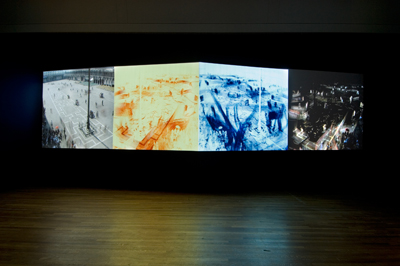
Seen
Computer, 2 projectors, Video Graphics Array (VGA) cables, custom software, digital source footage, 2 adjoining walls with a center angle between 190 and 220 degrees
Communicating Vessels - e-art: New Technologies and Contemporary Art - Ten Years of Accomplishments by the Daniel Langlois Foundation Jean-Noël Desmarais Pavilion, The Montreal Museum of Fine Arts
–
Photo MMFA, Christine Guest
David Rokeby, Seen (), at the Montreal Museum of Fine Arts' exhibition e-art: New Technologies and Contemporary Art
Duration 38 sec.
Video documentation: David Rokeby, Seen (2002), at the Montreal Museum of Fine Arts' exhibition e-art: New Technologies and Contemporary Art - Ten Years of Accomplishments by the Daniel Langlois Foundation (2007).
Seen was conceived for the Canadian Pavilion of the Venice Biennale of Architecture in 2002. The artwork examines visual perception and the passage of time by mapping the movement of people and pigeons in Piazza San Marco, Venice, Italy. This cinematic installation consists of four video projections displayed horizontally on two angled walls with images flipped to mirror their neighbour.
Seen is a digital artwork, heavily dependent on its computer programming. The computer software allows each of the four projections to present variations of the same real-time footage recorded in the Piazza. Seen was produced in an edition of three.
In the following video clip, David Rokeby explains the function of and relationship between Seen's (2002) projections .Footnote 3
David Rokeby, Seen (), at the Montreal Museum of Fine Arts' exhibition e-art: New Technologies and Contemporary Art
Duration 1:46
Read transcript
In the following video clip, David Rokeby explains the function of and relationship between Seen's (2002) projections.
" Seen" was originally commissioned as " Watch". The curator asked me to do " Watch" for the Venice Architecture Biennale, and I thought I wanted to take it further. The outside edges are basically " Watch". This is a source footage, here, the Piazza San Marco in Venice. This is now extracting all the still objects and leaving just what's moving, basically people and pigeons, and then this is tracing the trajectory of each thing in the space. So, where things are darkest, that's their present and there's a fadeout in the distance, into time, so you see the trajectory and direction of movement of each thing in Piazza San Marco. These little things down here are pigeons, and this configuration up there is a big battle for corn from tourists. And then, again from this image, but by looping it on itself, we get a kind of instant multi-motion study of everything happening in Piazza San Marco, each person becomes a sort of a procession of themselves, echoing perhaps the military and religious history of the square. And then finally, we have the far, the stillness side, removing everything that's moving and showing only what's still in the image. So the first and the last are the elements of " Watch", and the middle elements are further explorations of trying to visualize aspects of time in movement. I actually spent a lot of time, at a certain point, in my life, trying to imagine movement across time, and there was a brief moment, again looking out of my studio window in Spedina, when I actually saw the past and future of the cars that were going down the street in front of me, and in a way, a piece like this is trying to make that experience tangible and visible in some way.
1.2. Application of the Recommendations
Prior to acquiring Rokeby's Seen, The Montreal Museum of Fine Arts (MMFA) followed the Recommendations for the Acquisition and Long-term Management of Media Art Collections :
Step 1: Assemble and Analyze Documentation Relating to Seen
With the acquisition of Seen, the MMFA began assembling the necessary documents to include in the archival file of the artwork. However, further research and analysis was required in terms of Seen's exhibition history, technological description, and contractual agreement with the MMFA.
Exhibition History
Prior to Seen's presentation in e-art: New Technologies and Contemporary Art - Ten Years of Accomplishments by the Daniel Langlois Foundation (September 20 - December 9, 2007) and its subsequent acquisition by the MMFA, the artwork was featured in four exhibitions. The source of the footage used, the size and resolution of the projection, and the viewer's perspective differed in each installation. By reviewing the following installations, the MMFA was able to establish the presentation models that existed for Seen.
- Canadian Pavilion of the Venice Biennale of Architecture, Venice, Italy
- -
- Curated by Michael Awad and John Knechtel
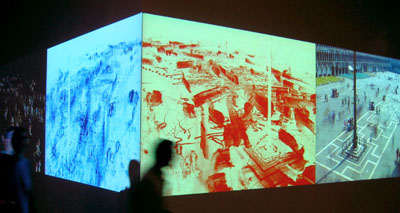
Seen, 2002
Installation view of the exhibition
Next Memory City / Toronto: Venice
Venice Biennale of Architecture, Venice, Italy
-
Courtesy of David Rokeby
Commissioned by the Alphabet City seriesFootnote 4 and the InterAccess Electronic Media Arts CentreFootnote 5, Seen made its debut at the Canadian Pavilion of the Venice Biennale of Architecture in 2002. An angled wall-which turned at a corner of approximately 60º-was created to display the horizontally aligned projections. The size of the projections was limited by the width of the pavilion. Exhibited alongside Eve Egoyan's sound piece, Channel, and Michael Awad's large-scale photograph, Chinatown, Seen was encountered by visitors from the side.
Seen was created specifically for the Venice Biennale, and this installation established the foundation for all future presentations of the artwork. Here, Rokeby describes Seen's original installation:
Within the pavilion, it was also clear that four projections side by side would be the most effective scenario. It was also clear that these projections would have to wrap around the inside wall of the pavilion. The best solution appeared to be to create a wall with an angle in the middle and project two pairs of projections, one on each of the walls, and meeting in the angled corner. The work evolved right up to the day of the opening, with several variations of the two central panes remaining options up to the last minute. The work was effectively finished when it was not longer possible for me to make further adjustments. (…) The Venice version had people entering from a position that prevented them from seeing the second set of images at first. This was quite effective, as it forced people to move about to experience the work… as such, its presentation echoed the interest in the way that people occupy space that inspired the work itself. Footnote 6
Rokeby used three different angles of Piazza San Marco in the Venice installation. In subsequent installations, Seen's content varied, focusing on one single source clip taken from the same angle.Footnote 7
- David Rokeby, Oakville Galleries, Oakville, Ontario, Canada
- -
- Curated by Su Ditta
Due to the size of the installation space, the scale of Seen at the Oakville Galleries was smaller than its original Venice installation. Moreover, Seen's resolution was less than Rokeby's preferred 1280 pixels across.
- David Rokeby: Silicon Remembers Carbon, Foundation for Art & Creative Technology (FACT), Liverpool, England, United Kingdom
- -
- Curated by Marta Rupérez

Seen,
Installation view of the exhibition
David Rokeby: Silicon Remembers Carbon
Foundation for Art & Creative Technology, Liverpool, England, United Kingdom
-
Courtesy of David Rokeby
- David Rokeby: Silicon Remembers Carbon, The Centre for Contemporary Arts (CCA), Glasgow, Scotland, United Kingdom
- August 4 - September 15, 2007
- Curated by Peter Ride
This traveling exhibition featured Seen in a larger format than the original Venice installation. However, the artwork was not projected at a full 1280 pixels across.
Visitors encountered the artwork head-on in Liverpool, enabling all four projections to be viewed at once. In Glasgow, Seen's presentation was reminiscent of the Venice installation, as visitors entered the exhibition space from the side.Footnote 8
Technological Description
The MMFA was faced with a technical choice regarding the components for Seen. In all previous installations, Seen had functioned using the following components:
- Rokeby's digital source video footage;
- Rokeby's personalized computer software;
- 2 (or 4) Digital Light Processing (DLP) Projectors;
- 1 MacPro 2.66 gHz Intel Computer;
- 2 Video Graphics Array (VGA) Cables.Footnote 9
Depending on the exhibition space, additional components may be required.
Rokeby indicated the possibility of Seen physically existing in two ways:
- Computer Version
-
The computer version is the original operative mode of Seen. Rokeby's personalized computer software allows each projection to present a variation of the same real-time footage. The sequences are looped and have a duration time of approximately 6 1/2 minutes.
The software entails regular modifications with each installation. Rokeby, the software's creator, typically performs these adjustments. However, if the computer version is acquired, the MMFA becomes responsible for these complex alterations.
- Optical Disc Version
-
Seen has always been exhibited as a computer version. During the acquisition process, Rokeby recommended that a Blu-ray Disc version be acquired by the MMFA. A newer form of the DVD, Blue-ray Discs can store more data and play high-definition video. The Blu-ray Disc would store the pre-recorded sequences from the computer version, making them easier to present. This would facilitate the MMFA's overall long-term management of Seen.Footnote 10
Contractual Agreement between Artist and Museum
At the time of acquisition, it was crucial that the MMFA clarify certain legal issues with Rokeby. Central concerns were concretely stated in a written agreement between Rokeby, the MMFA, and the Pari Nadimi Gallery (Rokeby's commercial representative), including:
- The right to exhibit the artwork;
- The reproduction of the artwork (photographs, print and electronic media, Internet, etc.);
- The editions of the artwork;
- The conservation and disposal of the artwork.Footnote 11
Step 2: Install Seen with Rokeby and Museum Staff
- e-art: New Technologies and Contemporary Art - Ten Years of Accomplishments by the Daniel Langlois Foundation
- The Montreal Museum of Fine Arts, Montreal, Quebec, Canada
- -
- Curated by Jean Gagnon

Seen,
Installation view of the exhibition
e-art: New Technologies and Contemporary Art - Ten Years of Accomplishments by the Daniel Langlois Foundation
Pavilion Jean-Noël Desmarais, The Montreal Museum of Fine Arts
-
Photo MMFA, Christine Guest
Prior to its acquisition, Seen was featured in e-art: New Technologies and Contemporary Art - Ten Years of Accomplishments by the Daniel Langlois Foundation, held at the Montreal Museum of Fine Arts (MMFA). For this exhibition, the MMFA's audio-visual technicians had the opportunity to collaborate and document the installation process with Rokeby.
Exhibited in a room of its own, the MMFA installation was different from the Venice installation in several ways:
- The size of the projections was larger;
- The resolution of the images was lower;
- Visitors encountered the work head-on;
- The walls met at an angle of approximately 120 degrees.
With regards to the e-art presentation, Rokeby said, "I did feel that the MBAM (MMFA) presentation was perhaps the most effective of all so far, in terms of the darkness of the room, the size of the projections, and the scale of projection to the size of room."Footnote 12
Installation Difficulties
During Seen's installation, however, the audio-visual technicians encountered certain difficulties:
Required Width of the Projection
The complete projection width is expected to measure ten metres. Due to the smaller room size, the depth of the e-art exhibition space and the lens of the projector, the complete projection width was diminished. To reach the appropriate projection width, it would have been necessary to install each projector outside of the room's parameters.
Diagramme de l'installation de Vu dans la salle d'exposition e-art.
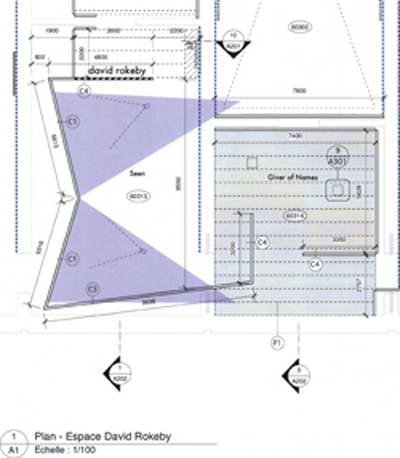
To resolve this difficulty, the MMFA technicians installed two flat, high-quality mirrors (30.5 inches x 40.5 inches) directly behind each projector in the exhibition space.Footnote 13 This allowed each image to be reflected from the projector onto the mirror and subsequently
Projector and mirror installation of David Rokeby's Seen in e-art exhibition.
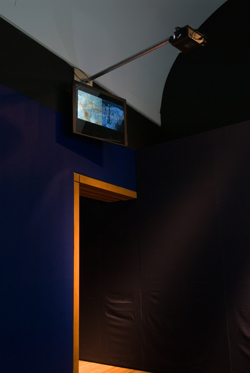
The flexibility and weight of the mirrors suspended from the walls caused distortions in each projection, forcing Rokeby to adjust his software several times. Rokeby describes this installation challenge by stating:
This [mirrors] was a necessary apparatus to achieve the size of image in the space we had. It might have been slightly distracting. More importantly, it was difficult to set up and took some time to settle. A direct projection scenario with a wider angled projection would be simpler.Footnote 14
Rebooting the Computer
Seen's computer needed to be rebooted each morning to ensure the artwork's computer program functioned properly.
Step 3: Prepare a Questionnaire for Rokeby
The information gathered from the previous steps led the Montreal Museum of Fine Arts (MMFA) to realize that a record of Rokeby's detailed knowledge was needed for Seen. To fill the information gaps, the MMFA developed a questionnaire tailored to Rokeby and Seen which incorporated the interests of the MMFA's various departments. The questionnaire explores Seen's concept, presentation, conservation, and intellectual property issues.
Step 4: Develop Conservation Strategies
Once Rokeby had completed the questionnaire, the various Montreal Museum of Fine Arts (MMFA) departments worked together to consolidate the best conservation strategies for the long-term management of Seen. The following elements were clarified:
Authenticity and Integrity
For Rokeby, Seen's materiality is not an integral part of the artwork. Even though Seen's functionality depends on its technical components, they do not have any aesthetic or visitor experiential value to Rokeby. He explains that:
The delivery mechanism for the video is irrelevant. Whether it is being processed in real-time by the computer or played as a static video is irrelevant. The projection system should ideally be capable of presenting the video at full resolution. Footnote 15
To Rokeby, the authenticity and integrity of the artwork lies in its spatial experience-that is, in the size and resolution of the video projection. The interchangeability of the technical components will facilitate the MMFA's ability to prolong Seen's lifespan.
Ideal Exhibition Context
Based on Rokeby's feedback pertaining to Seen's previous installations, the MMFA was able to establish the details of a satisfactory presentation. Moreover, Rokeby defines Seen's ideal installation as follows:
The work is silent and should be in a reasonably quiet space. The ideal width of the full set of projections is about 10 metres. The wall colour should be white behind the projectors and a darker grey elsewhere (60 to 90% black). The materials of construction are not significant. The angle at the centre of the projection should be between 190 and 220 degrees, but can be adjusted somewhat to suit the space. The distance from the projection to the facing wall needs to be at least 5 metres and more importantly needs to provide sufficient projection distance to achieve the desired image size. There should be as little additional lighting in the space as possible. Sitting [seating] for public is a nice idea but not necessary. Footnote 16
Optimal Viewer Experience
Rokeby describes his desired visitor experience for Seen:
This work is initially felt in the visual cortex of the viewer. You are not initially sure what you are seeing, but the various images engage various parts of your perception quite directly. Generally, people slowly work out what they are seeing, and begin comparing between channels and deciphering in this manner. In an ideal scenario, the angled wall and design of the space encourages the viewer to move around the space somewhat to experience the work. The work should be somewhat overwhelming… scale helps. Each pane should be large enough to dominate your field of view if you are standing in the middle of the room. You should be able to immerse yourself in each pane. Footnote 17
Potential Conservation Issues
For long-term conservation purposes, Rokeby recommends that the MMFA purchase the optical disc version (Blu-ray Disc) rather than the computer version. Rokeby explains the potential problems with each version:
The computer-based version is subject to computer failure and eventual [obsolescence] of the required computer. The preprocessed version on Blu-ray and DVD-R is subject to the deterioration issues of optical media, but this can be managed as any video work. The solid state player would be the most trouble-free scenario. The Flash memory may eventually degrade, but the DVD-R data mpeg-2 files can be reloaded onto Flash memory if the original flash memory fails. Footnote 18
In the end, the Museum decided to acquire both versions of Seen - the computer-based version and the Blu-ray version. This will ensure flexibility in ways to conserve the artwork over the long term.
Step 5: Organize Documentation through the Archival File of the Artwork and Database
In the following video clip, David Rokeby comments on the scarce documentation that he has collected over the years regarding his artworks.Footnote 19
David Rokeby comments on the scarce documentation that he has collected over the years regarding his artworks
Duration 56 sec.
Read Transcript
David Rokeby comments on the scarce documentation that he has collected over the years regarding his artworks.
I don't usually take many notes. I remember them… I try to document the shows so that I can see what I've done, and I do keep copies of the code and the modified version of the program. For many pieces, it's just a question of changing a threshold, if it's an interactive piece, making it more or less sensitive, for example. And I keep copies of all those. Initially, in case something happens during the show, but also, I have something to refer back to, if I'm in a similar situation with a similar machine; I have some examples of how I've solved it before. Yes, I haven't… most of the notes are up here (points to his head)… they're not… I don't have a nice archive of exhibition number X of watched changes…
It is therefore crucial that the Archives Department of the Montreal Museum of Fine Arts (MMFA) keep hard copies of all relevant documentation pertaining to Seen. Rokeby recommends that the MMFA assemble photographic and video documentation as well as layout diagrams of previous presentations of the artwork for reference purposes.Footnote 20 The MMFA's cataloguer, registrar and conservator must organize and record the assembled documentation into the MMFA's internal collections management database, Mimsy XG. This database is used for all artworks in the MMFA's collection, including media artworks.
The case studies conducted by the DOCAM Cataloguing Structure Research Committee allowed the MMFA's Archives Department to review its Mimsy XG database in 2008. The MMFA's cataloguer analyzed how certain types of information relating to the MMFA's collections, most notably media art, could be incorporated into existing categories. The following information was subsequently integrated into the database:
- Artwork Description: quotes curatorial publications that contain interpretations of the artwork;
- Technical Description: enables an understanding of the artwork's operating modes;
- Artwork Components: describes the evolution and deterioration of the artwork's physical condition from the time of acquisition to its current condition;
- Exhibition History: includes information, photographs and diagrams from the artwork's different exhibition contexts;
- Installation Instructions: details the artwork's various installations;
- Conservation History: includes information and condition reports relating to the conservation of the artwork, including modifications and potential recommendations for the maintenance and security of the equipment;
- Storage Specifications: describes the artwork's storage and shipping conditions and requirements;
- Interview with artist: focuses on the concept, presentation, conservation and intellectual property issues of the artwork.
Step 6: Document Future Installations of Seen
In order to maintain, conserve and recreate an optimal experience of Seen for museum visitors, the Montreal Museum of Fine Arts (MMFA) recognizes the importance of documenting future exhibitions of the artwork. In addition to installation diagrams, photographs and videos, this documentation includes recorded interviews with the artist, staff and museum visitors. These documents would then be incorporated into the MMFA's Mimsy XG database.
Museums are beginning to record the visitor's experience as a complementary form of documentation. Interviews with visitors reveal the subjective experience of the artwork. As part of her research residency at the Daniel Langlois Foundation,Footnote 21 Lizzie Muller documented visitors' experiences of various artworks, n-cha(n)t, and The Giver of Names during the e-art: New Technologies and Contemporary Art - Ten Years of Accomplishments by the Daniel Langlois Foundation exhibition at the MMFA.
Unfortunately, Seen was not included in this research. However, the results of Muller's research underscore the importance of recording visitors' experiences. These responses would then be integrated into the archival file of the artwork.
2. DANIEL DION (in collaboration with Su Schnee): The Moment of Truth (1991)
Using Daniel Dion's The Moment of Truth (1991), this case study describes:
- An introduction to the artist and his artwork;
- The application of the Recommendations for the Acquisition and Long-term Management of Media Art Collections.
2.1. Introduction
2.1.1. Acquisition and Long-term Collections Management Context
In 1999, the Montreal Museum of Fine Arts (MMFA) acquired The Moment of Truth by Daniel Dion for its Canadian video art collection. Since its acquisition, The Moment of Truth has been featured in two of the MMFA's exhibitions showcasing its permanent collection of contemporary art.
2.1.2. Daniel Dion and Su Schnee
Born in 1958 in Montreal, Quebec, Daniel Dion studied Communications at Université du Québec à Montréal. Working in photography, video, performance and installation, Dion's artistic practice focuses on theoretical, aesthetic and spiritual paradigms that marry art and communications. Dion has exhibited throughout Canada, Europe and Asia and has been involved in cross-cultural art exchanges with India, Cuba and Japan.Footnote 22
Artist Su Schnee collaborated with Dion to create The Moment of Truth. Born in Toronto, Ontario, in 1959, Schnee studied at the Capilano College of Art and Design in North Vancouver and the Vancouver School of Art (now the Emily Carr University of Art + Design).Footnote 23 In her artwork, Schnee combines different artistic mediums, such as painting and drawing. She has exhibited in Canada and Europe. Dion and Schnee co-founded OBORO in 1982. OBORO is an artist-run centre dedicated to the presentation and production of art, contemporary practices and new media.
2.1.3. The Moment of Truth (1991)
Video documentation: Daniel Dion, The Moment of Truth (1991).
The Moment of Truth is an installation consisting of a portable video player that is mounted on a wall and plays a looped 100-second video. The video montage includes images of ocean water, swaying trees, fire, Chinese meditation balls rotated in the palm of a hand, and a path through a forest.
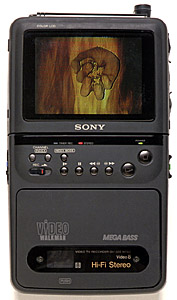
The Moment of Truth
SONY Video-Walkman video source footage on an 8mm video cassette, rechargeable batteries
14 x 9 x 4.3 cm, length: 100 seconds
The Montreal Museum of Fine Arts
Purchase, Harold Lawson, Marjorie Caverhill, Harry W. Thorpe and Mona Prentice Bequests
Photo MMFA, Brian Merrett
Read Transcript
The audio component emits sounds produced by a metronome and a synthesizer that reverberate in a crescendo manner. A voice repeats the following mantra twelve times: "Seventy-seven billion human beings have lived on this planet." The video sequence ends with: "Four billion live here now."
This poetic artwork is a reflection on the vastness of humanity. It responds to the effects of globalization and the electronic age. The repetitive mantra investigates both the current state of the planet and its past histories.
In the following video clip, Daniel Dion explains his artistic process and methodology for The Moment of TruthFootnote 24(available in French only).
Daniel Dion explains his artistic process and methodology for The Moment of Truth
Duration 2:23
Read transcript
Daniel Dion explains his artistic process and methodology for The Moment of Truth
PRIM [Media Arts Centre] had asked people to produce a minute, a one-minute creation, whatever they wanted. So I decided to try to do something different from my video practice, which has always essentially been close to installation and performance. I have always tried to work the material, not simply in narrative form, but so that I can build on it. It's almost like architecture, to some extent. That is one aspect. The other aspect mainly involved theoretical research. I was interested in the whole Buddhist aspect some twenty years ago. I'm still interested - it's not like I used to be interested and now I'm not anymore - but the whole notion of transformation of ideas… not the idea of life after death, but of continuity… the idea of cycles, the idea of repetition and all that, and so I often documented things that were shown on television. I was working on another project with a friend, on which we were doing re-recording - this was a little before scratch video and all that. We were re-recording from television and there was this phrase in a documentary that really influenced me: "77 million humans have lived on this planet, 6 billion live here now." And that stayed in my mind - accumulation, the passage of time and all that. So I got this idea and I said to myself: "That would be a really great minute, the idea of the cycle, the idea of the minute on a clock-you know, the cycle of a watch, a clock, of time passing. The idea came to me and then I produced this. Based on sequences that aren't re-recorded from television, but footage I shot myself. Most of them were wanderings sequences. And since then, I have a bank, archives, my God, that date back years, from the early 80s and my many travels all over the world. So, either on a train or walking, I accumulated hours and hours of documents where you see nothing except the landscape or the highway or the road or the sky or the edge of the road flowing by. So that idea, the idea of repetition, the idea of the passing of time, led me to put this together.
2.2. Application of the Recommendations
To ensure the long-term conservation and documentation of The Moment of Truth, the Montreal Museum of Fine Arts (MMFA) followed the Recommendations for the Acquisition and Long-term Management of Media Art Collections.
Step 1: Assemble and Analyze Current Documentation Relating to The Moment of Truth
To gain a better understanding of the management of The Moment of Truth thus far, the Montreal Museum of Fine Arts (MMFA) evaluated the current state of its documentation. Upon analysis, the MMFA noted discrepancies between The Moment of Truth's technological description and exhibition history.
Technological Description
At the time The Moment of Truth was acquired, the MMFA obtained the following components with the artwork:
- Watchman Sony Video Walkman (Model GV-300);
- Sony Adapter (Model AC-V50);
- 2-hour looped sequence on 8mm video format;
- Broadcast-quality version of the video sequence on Betacam SP (submaster of artwork);
- Electrical wiring.Footnote 25
Exhibition History
The Moment of Truth was first presented in a 1992 group exhibition at the Brenda Wallace Gallery in Montreal, Quebec, Canada. Installed in a small alcove, the artwork and its video sequence were presented on a battery-operated Sony Video Walkman using an 8mm cassette. After the looped sequence played for 56 minutes, the cassette had to be rewound and restarted by a gallery attendant.Footnote 26
Prior to its acquisition by the MMFA, The Moment of Truth was featured in several other exhibitions, including:
- Terra Incognita, Expression (Saint Hyacinthe, Quebec, 1993);
- Cent jours d'art contemporain de Montréal, Centre International d'Art Contemporain de Montréal (CIAC) (Montreal, Quebec, 1994);
- Videofiesta, Expoarte Guadalajara (Guadalajara, Mexico, 1996);
- Convergence 96 (Mysore, India, 1996).Footnote 27
The Moment of Truth was only exhibited on the Sony Video Walkman for a short period of time due to equipment failure. As a result, the MMFA needed to find a different way to display the video sequence. Using a Casio handheld TV model, the video was played through an external DVD player in an exhibition hall alongside other contemporary artworks. The MMFA presented The Moment of Truth in the following two exhibitions:
- Of Pictures and a Thousand Words: Luminous Projections from the Montreal Museum of Fine Arts' Collection of Contemporary Art (2002);
- High Points: Selection from the Collection of Contemporary Canadian Art (2004).
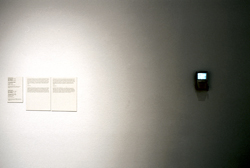
The Moment of Truth,
Installation view of the exhibition (with new Casio handheld TV model)
High Points: Selection from the Collection of Contemporary Canadian Art
The Montreal Museum of Fine Arts
-
Photo MMFA, Brian Merrett
Technological Evolution
Video Player: Sony to Casio
These photographs show The Moment of Truth in its storage casing before and after the equipment changes:
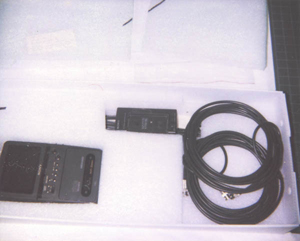
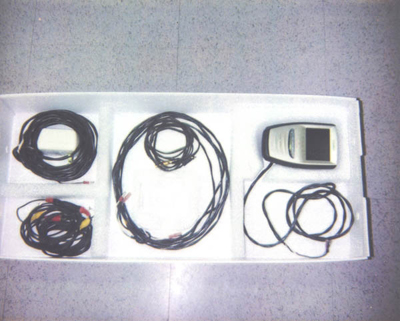
Because The Moment of Truth was exhibited several times, deficiencies began to occur with the Sony Video Walkman's screen used to display the video sequence. Specifically, the LCD screen would not stay lit and would shut off after only a few seconds.
Beginning in 2001, the MMFA's curator of contemporary art, Stéphane Aquin, worked collaboratively with Dion to find a solution that would enable the re-exhibition of The Moment of Truth. Two solutions were proposed:
- Repair the Sony Video Walkman;
- Replace the Sony Video Walkman.
Primarily, Dion hoped to repair the Sony Video Walkman-he wanted the artwork to retain the vintage appearance of its 1991 conception, thus affirming the technological historicity as a prime value of the artwork. The technology of the Sony model allowed users to watch a video while in transit. Viewers would have to make their own tapes, as pre-recorded materials were not issued on the 8mm video format at that time.
Upon inspection, it was determined that the Sony Video Walkman was unusable. Since its repair was not an option, Dion recommended a smaller Casio handheld TV model -a newer and modified version of the portable video player. In 2002, the Casio was purchased and replaced the Sony model for all future installations.Footnote 28
Unlike the original Sony Video Walkman, the Casio model plays video by means of an externally connected VHS or DVD player hidden behind a wall. As a result, it does not include an 8mm cassette player. It was therefore essential that the MMFA migrate the video sequence from 8mm video format to DVD.
Video Source: 8mm video format to DVD
In 2002, to keep up with current technology, the MMFA's Conservation Department requested that the Audio-Visual Department migrate the 8mm video version of The Moment of Truth to DVD format. This DVD plays the video sequence on the Casio model.
The MMFA currently owns an archival and exhibition copy of The Moment of Truth in DVD format in addition to the original 8mm copy and Betacam SP submaster that Dion provided at the time of acquisition. This migration was conducted using the Betacam SP submaster as content source.
Storage
To conserve The Moment of Truth's technological context, the Sony Video Walkman was put into storage.
Step 2: Install The Moment of Truth
Installation Instructions
As a result of the audio-visual knowledge and experience required to mount media artworks, the creation of an instruction manual facilitates future installations. The MMFA drafted the following instructions for the Casio handheld TV model:
- Remove the artwork's components from the storage unit;
- Attach the Plexiglas mounting device to the wall by inserting two screws into the pre-drilled holes at the back of the mount. Note: Ensure that the centre of the Casio screen is at 64 inches from the floor;
- Insert the Casio model into the mount while connecting the power cable of the transformer to the instrument;
- Hide both the power cable and the fixed video/audio signal cable behind the wall along the base of the instrument;
- Bring the video and sound signals from the external DVD source hidden behind the wall to the Casio. Bring the transformer to an electronic power source;
- Depending on the room and its spatial configuration, adjust the sound level on the Casio model so that it is perfectly audible at a distance of 20 inches. Note: you may have to lift the instrument from its mount to do so;
- Use the playback or loop function on the DVD source to eliminate the technical management of the artwork during its public exhibition.
The brightness and contrast of the Casio model's screen should be adjusted to "normal" when directly viewing the screen. The volume should be low at the beginning of the video sequence and progressively become louder. To assist the technicians hanging the artwork, Dion marked the screen and audio stabilizers at the appropriate levels with a piece of masking tape. The masking tape is removed once the artwork is installed.
Step 3: Prepare a Questionnaire for Dion
The information gathered from the previous steps led the Montreal Museum of Fine Arts (MMFA) to realize that a record of Dion's detailed knowledge about all aspects of the artwork was needed for The Moment of Truth. To fill the information gaps, the MMFA specifically developed a questionnaire tailored to Dion and The Moment of Truth, incorporating the interests of the MMFA's various departments. The questionnaire explores The Moment of Truth's concept, presentation, conservation and intellectual property issues. In 2008, the MMFA had the opportunity to record a video interview with Dion and complete the questionnaire.
Step 4: Develop Conservation Strategies
Once the interview with Dion was realized, the various departments at the Montreal Museum of Fine Arts (MMFA) worked together to consolidate the best conservation strategies for the long-term management of The Moment of Truth. The following elements were clarified:
Authenticity and Integrity
Dion believes that the authenticity of The Moment of Truth lies in the portable video player. He wants the video sequence to be viewed through equipment that represents the era in which it was created. Dion wishes to retain the vintage appearance of The Moment of Truth so that it alludes to the analog generation. Transforming the artwork to digital technology-such as an iPod-is not an option for the artist.Footnote 29
Ideal Exhibition Context
Since The Moment of Truth has been exhibited in various ways, it was important that the MMFA determine Dion's optimal exhibition context for the artwork. Thus, the MMFA discussed The Moment of Truth's installation with Dion.
The exhibition space for The Moment of Truth is intimate. In a quiet, dimly lit room, the handheld portable video player is hung on a wall. The viewer hears faint sounds and a voice. The images and audio become clearer as the viewer approaches the portable video player. When exhibited, Dion's artist statement accompanies the artwork :
The Moment of Truth is the moment the human race has been living for millions of years; the moment that takes place every day of our lives; the moment that makes us conscious of the immensity whence our consciousness springs. It is both a poem and a canon, a whirling that relates the virtuality of our existence: "Seventy-seven billion human beings have lived on this planet, four billion live here now" (1991). Footnote 30
In the following video clip, Daniel Dion discusses the ideal exhibition context of The Moment of Truth Footnote 31 (available in French only).
Read transcript
Daniel Dion discusses the ideal exhibition context of The Moment of Truth
I wanted to present it in as neutral a context as possible, and so I stayed away from anything theatrical. However, I wanted it to play well, because those monitors are not very friendly visually. Monitors have gotten much better since then. Anyway, so I tried to set up the lighting as best I could, to make it play well, but it wasn't like it was something that needed complete darkness with people tiptoeing up and down the aisles for fear of making noise or something like that. I just wanted to keep it as neutral, as simple as possible. So people would just see it and then say, "Okay, what's that?" And then they'd find it a little interesting. The audio's also not very loud. At first, it was… well, it was on purpose that it didn't reach out and grab people, instead it just kind of drew them in. It was small. And then when you go closer, you can hear what's happening. And I think the volume - if I recall correctly - the volume increases a little as it goes along, once again, just to kind of draw people in, that kind of thing. But it's not like some kind of crescendo; it's just there to kind of mark the moment.
Potential Conservation Issues & Strategies
As mentioned above, The Moment of Truth has undergone two major transformations to its technological components:
- The Sony Video Walkman was replaced by a Casio handheld TV model;
- The video source footage was migrated from 8mm video format to DVD.
The future of The Moment of Truth is dependent on the lifespan of its technological components. In the case of their failure or obsolescence, the MMFA's various departments must work collaboratively to manage, conserve and replace the artwork's components and must base their decisions on the responses Dion provided in the interview.
Duplication
In early 2009, the MMFA was in search of a functional Sony Video Walkman. During the interview, Dion mentioned his preference that a vintage Sony Video Walkman be used for future exhibitions. Online auction and shopping Web sites such as eBay increase the chances of the MMFA finding another Sony Video Walkman. Richard Gagnier, Head of the Conservation Department at the MMFA, has suggested acquiring two functional Sony models and one Casio model to keep in storage until it becomes necessary to change the current equipment. In early 2009, both models were available for purchase on ebay.
Emulation
The replacement of a specific component of the video player can also be considered as a conservation strategy. For example, this could involve embedding a new, flat LCD screen into the original Sony Video Walkman's casing. The replacement of its screen would allow for the conservation of the original portable video player.
Migration
Video storage technologies are constantly evolving. Once DVDs are replaced by newer technologies, such as Blu-ray Discs, the MMFA will migrate The Moment of Truth's video sequence to the updated video storage version.
Step 5: Organize Documentation through the Archival File of the Artwork and Database
Over the years, Dion has archived very little documentation with regards to his artworks. It is therefore crucial that the Archives Department at the Montreal Museum of Fine Arts (MMFA) keep hard copies of all relevant documentation pertaining to The Moment of Truth. The MMFA's cataloguer, archivist and conservator must organize and enter the assembled documentation into the MMFA's internal collections management database, Mimsy XG. This database is used for all artworks in the MMFA's collection, including media artworks.
The case studies conducted by the DOCAM Cataloguing Structure Research Committee allowed the MMFA's Archives Department to review its Mimsy XG database in 2008. The MMFA's cataloguer analyzed how certain types of information relating to the MMFA's collections, most notably media art, could be incorporated into existing categories. The following information was subsequently integrated into the database:
- Artwork Description: quotes curatorial publications that contain interpretations of the artwork;
- Technical Description: enables an understanding of the artwork's operating modes;
- Artwork Components: describes the evolution and deterioration of the artwork's physical condition from the time of acquisition to its current condition;
- Exhibition History: includes information, photographs and diagrams from the artwork's different exhibition contexts;
- Installation Instructions: details the artwork's various installations;
- Conservation History: includes information and condition reports relating to the conservation of the artwork, including modifications and potential recommendations for the maintenance and security of the equipment;
- Storage Specifications: describes the artwork's storage and shipping conditions and requirements;
- Interview with artist: focuses on the concept, presentation, conservation and intellectual property issues of the artwork.
Step 6: Document Future Installations of The Moment of Truth
In order to maintain, conserve and recreate an optimal viewing experience of The Moment of Truth for museum visitors, the Montreal Museum of Fine Arts (MMFA) acknowledges the necessity of documenting future exhibitions of the artwork. This documentation includes installation diagrams, photographs and videos as well as recorded interviews with the artist, staff and visitors. These documents are then incorporated into the MMFA's Mimsy XG database.
Museums are beginning to record the visitor's experience as a complementary form of documentation.Footnote 32 Interviews with visitors reveal the subjective experience of the artwork. For example, as part of her research residency at the Daniel Langlois Foundation,Footnote 33 Lizzie Muller documented visitors' experiences of various artworks during the e-art: New Technologies and Contemporary Art - Ten Years of Accomplishments by the Daniel Langlois Foundation (Fall 2007) exhibition at the MMFA. The results of her research underscore the importance of recording visitors' experiences. These responses are then integrated into the artwork's archival file.
Contact information for this web page
This resource was published by the Canadian Heritage Information Network (CHIN). For comments or questions regarding this content, please contact CHIN directly. To find other online resources for museum professionals, visit the CHIN homepage or the Museology and conservation topic page on Canada.ca.
Page details
- Date modified: